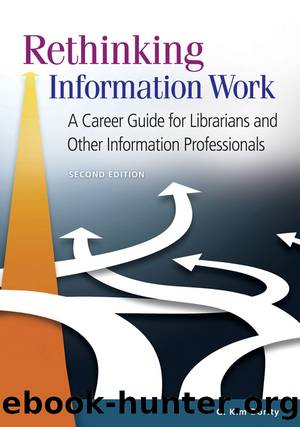Rethinking Information Work by G. Kim Dority

Author:G. Kim Dority [G. Kim Dority]
Language: eng
Format: epub
ISBN: 9781610699600
Publisher: ABC-CLIO
6
Understanding, Describing, and Documenting Your Value
If you donât know what you bring to the table, you wonât get a seat there.
âDan Schwabel
Youâve explored your unique interests, aptitudes, and preferences. Youâve looked at traditional, nontraditional, and independent career options that build on your LIS professional skills. Now itâs time to consider how those skills match up with the career opportunities you might want to pursue. To do that, youâll need to rethink, reframe, and rephrase how you interpretâand presentâthose skills.
In the library profession, we generally think of our skills in terms that connect with readily understood and categorized positions: for example, reference, readersâ advisory, cataloging, circulation, network administration, archives, and collection development.
These positions are essentially âpredefinedâ for us. For example, we expect that good reference librarians know how to answer questions asked by patrons, students, faculty, and employees. They know how to interview patrons to clearly understand their questions, know the range of information resources that are appropriate to the task, and are able to use them effectively and successfully to deliver the correct answers. Top-notch reference librarians are usually also adept at:
Teaching others how to find and use appropriate information resources.
Preparing print and online tutorials and guides on specific subjects.
Creating and presenting workshops and seminars on information topics of value to their audiences.
Continually monitoring multiple sources to learn about (and how to use) new information resources.
Evaluating competing information resources and providers and recommending which to use, license, or purchase.
Evaluating online resources for authority, credibility, and usefulness.
Creating a supportive, welcoming dynamic to diffuse the library âintimidation factorâ for patrons.
Creating online content for the libraryâs web portal for special communities of users.
Tracking down information that might seem impossible to find to others.
Listening for the nuances within a patronâs question that indicate a different directionâor answerâmight be warranted.
Maintaining a positive attitude toward patrons despite the occasional challenges of dealing with the public, students, coworkers, and bosses.
Download
This site does not store any files on its server. We only index and link to content provided by other sites. Please contact the content providers to delete copyright contents if any and email us, we'll remove relevant links or contents immediately.
Phoenicians among Others: Why Migrants Mattered in the Ancient Mediterranean by Denise Demetriou(577)
Verus Israel: Study of the Relations Between Christians and Jews in the Roman Empire, AD 135-425 by Marcel Simon(576)
Caesar Rules: The Emperor in the Changing Roman World (c. 50 BC â AD 565) by Olivier Hekster(558)
Europe, Strategy and Armed Forces by Sven Biscop Jo Coelmont(504)
american english file 1 student book 3rd edition by Unknown(481)
Give Me Liberty, Seventh Edition by Foner Eric & DuVal Kathleen & McGirr Lisa(469)
Banned in the U.S.A. : A Reference Guide to Book Censorship in Schools and Public Libraries by Herbert N. Foerstel(467)
The Roman World 44 BC-AD 180 by Martin Goodman(458)
Reading Colonial Japan by Mason Michele;Lee Helen;(457)
Basic japanese A grammar and workbook by Unknown(456)
DS001-THE MAN OF BRONZE by J.R.A(443)
The Dangerous Life and Ideas of Diogenes the Cynic by Jean-Manuel Roubineau(440)
Introducing Christian Ethics by Samuel Wells and Ben Quash with Rebekah Eklund(433)
Imperial Rome AD 193 - 284 by Ando Clifford(432)
The Oxford History of World War II by Richard Overy(432)
Literary Mathematics by Michael Gavin;(392)
Language Hacking Mandarin by Benny Lewis & Dr. Licheng Gu(380)
Catiline by Henrik Ibsen--Delphi Classics (Illustrated) by Henrik Ibsen(369)
How to Reach the 9.0 in IELTS Academic Reading by IELTS Medical(358)
